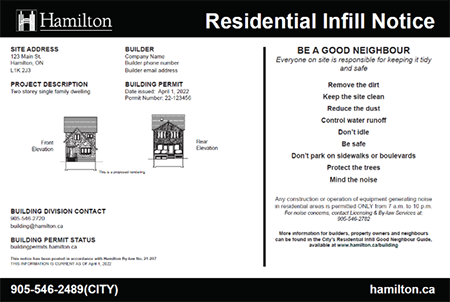Residential Infill Construction

Building Division
City Hall, 3rd Floor
71 Main Street West, Hamilton
Call 905-546-2720 or
Email [email protected]

Residential Infill Notice
Residential infill projects for construction and/or demolition must post an Information Notice on the site containing specific information about the project.
This notices helps to improve communication with the public about what is taking place in their neighbourhood together with contact information.
Residential Infill Information Notice
The City of Hamilton's By-law 21-207 to Regulate Public Notices at Infill Construction Sites requires residential infill projects (construction and/or demolition) to post an Information Notice on the site containing specific information about the project.
The Information Notice is intended to improve communication with the public about what is taking place in their neighbourhood together with contact information.

An Information Notice is required for:
- Construction of a new detached or semi-detached house on a vacant lot;
- Demolition of an existing detached or semi-detached house and construction of a new detached or semi-detached house on an existing lot;
- Demolition of an existing detached or semi-detached house where there is no proposed construction of a replacement house;
- The construction of an addition, or additions, to an existing detached or semi-detached house where the combined total area of the additions is 100 m2 (1076 ft2) or more; and
- The construction of a detached secondary dwelling unit.
An Information Notice is NOT required for:
- A new detached or semi-detached house in a plan of subdivision registered 5 years or less from the date of construction of the new house; or
- A new detached or semi-detached house in an agricultural or open space zone.
To obtain an Information Notice (Construction or Demolition), you must submit to the Building Division, in conjunction building permit submission to construct and/or demolish:
- A completed Infill Information Notice Declaration Form
- For new construction, electronic black and white renderings of the front and rear elevation of the building as it is expected to look following the completion of the project (JPEG format, minimum resolution of 300 dpi; no 3D renderings).
- How to submit renderings:
- Renderings can be submitted to the plan reviewer via email.
- Alternatively, the renderings can be emailed to [email protected] (include the project address in the subject line).
- How to submit renderings:
Printing Information Notice
An electronic file containing a print-ready (PDF format) Information Notice will be provided to the applicant or owner. The applicant or owner is responsible – at their own cost – to print the Information Notice, in accordance with the specifications in By-law 21-207.
- Minimum size: 0.61 m (24”) wide and 0.41 m (16”) high
- Material: Coroplast, corrugated Polypropylene plastic, or other durable weather resistant material.
No changes or additions to the content of the notice are permitted.
Posting Information Notice
- One (1) Information Notice is required for every lot line of the property that faces the street.
- Demolition: The Information Notice must be posted prior to the commencement of demolition.
- Construction: The Information Notice must be posted within (5) business days of the commencement of construction.
- The Information Notice must be displayed in accordance with By-law 21-207:
- Each Information Notice shall face a street;
- Each Information Notice shall be displayed such that the bottom of the Information Notice is at least 0.61 m (24”) from grade;
- Nothing shall obscure or block the view of the Information Notice; and
- Each Information Notice shall be erected in a safe and secure manner.
- Within 24 hours of erecting the Information Notice at the property, a photograph must be sent to [email protected].
When to Remove Information Notice
- For demolition, the Information Notice shall remain displayed until the demolition is completed.
- For construction, the Information Notice shall remain displayed until an Occupancy Permit has been issued.
Good Neighbour Guide
Cities such as Hamilton are in a constant state of change. Some of this change is focused in Hamilton’s residential neighbourhoods, where people demolish and build, build on an existing vacant lot, or renovate older houses. The City of Hamilton calls this process of building and renovating in established neighbourhoods ‘residential infill’.
This guide is intended for property owners, builders, and contractors starting a construction project in an established neighbourhood, and for area residents. The guide outlines requirements and best practices for residential infill construction, as well as communication tips to help everyone involved move smoothly through the project. The guide is not intended to anticipate or solve all issues that may arise, but provides some guidance and contact information to assist, whether you are a property owner, builder/contractor or community member/neighbour.
Residential infill can contribute to the health, vitality, and value of neighbourhoods, including improving property values. Residential infill also contributes to the protection of green space, farmland, forests, wetlands, and watersheds in Ontario’s greenbelt. Instead of building out, the city is building up and intensifying.
However, construction can also result in negative impacts on neighbours and the community. If the project is not well planned, managed, or communicated, construction can be disruptive and damaging. Property owners are to ensure that new home builders are reputable and registered with Tarion.
Builders earn the trust and respect of neighbours by observing all by-laws and by taking steps to minimize the potentially negative impacts of construction.
